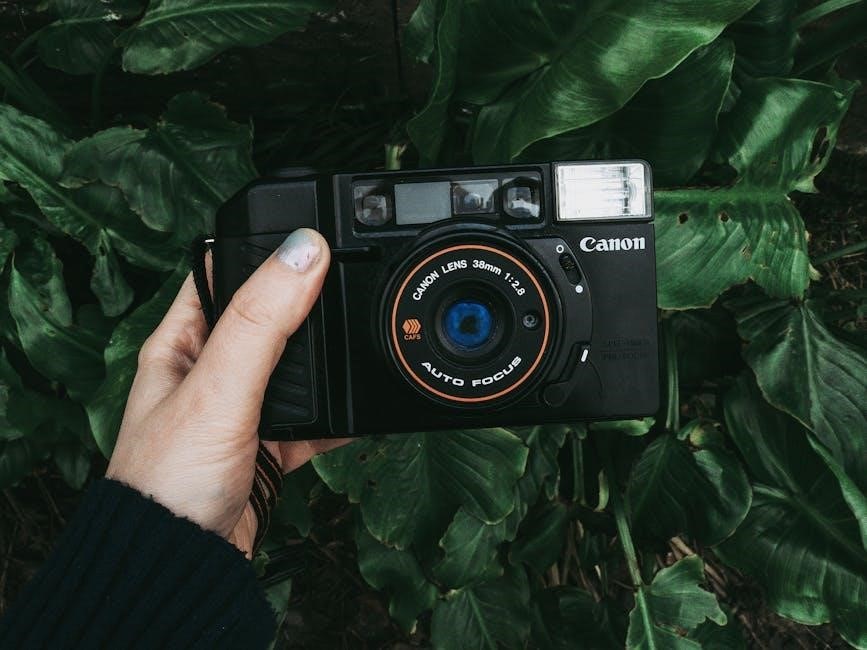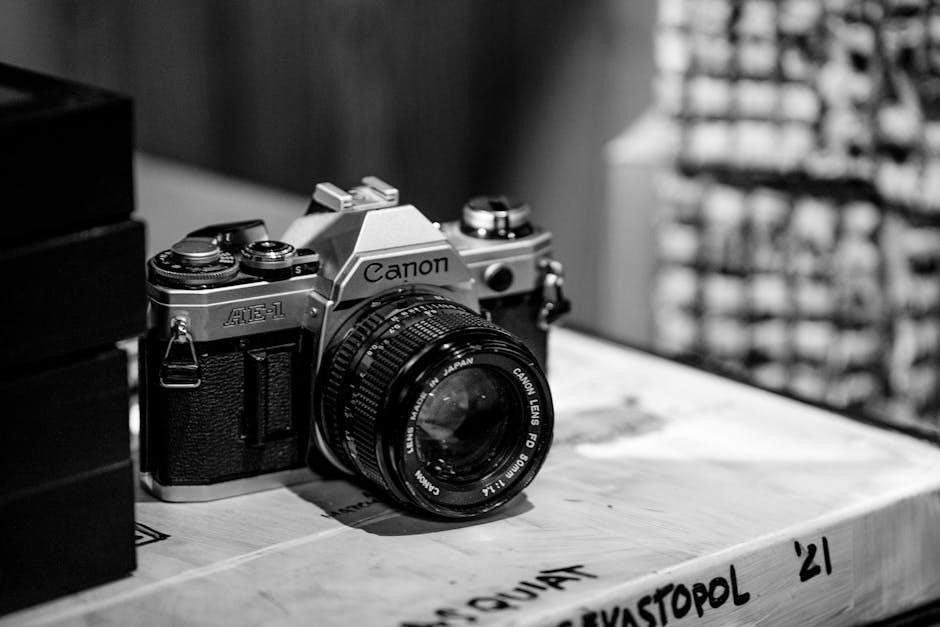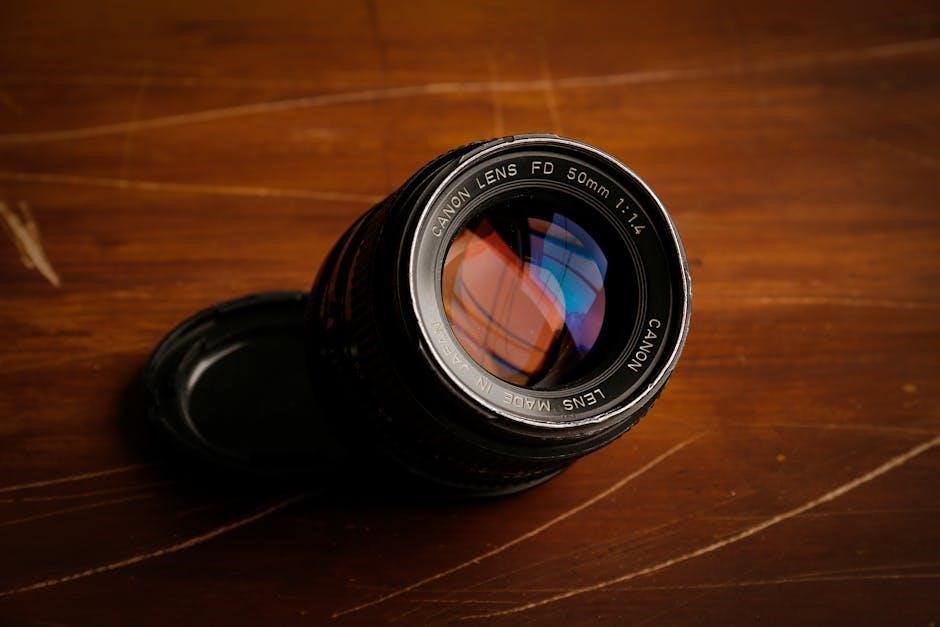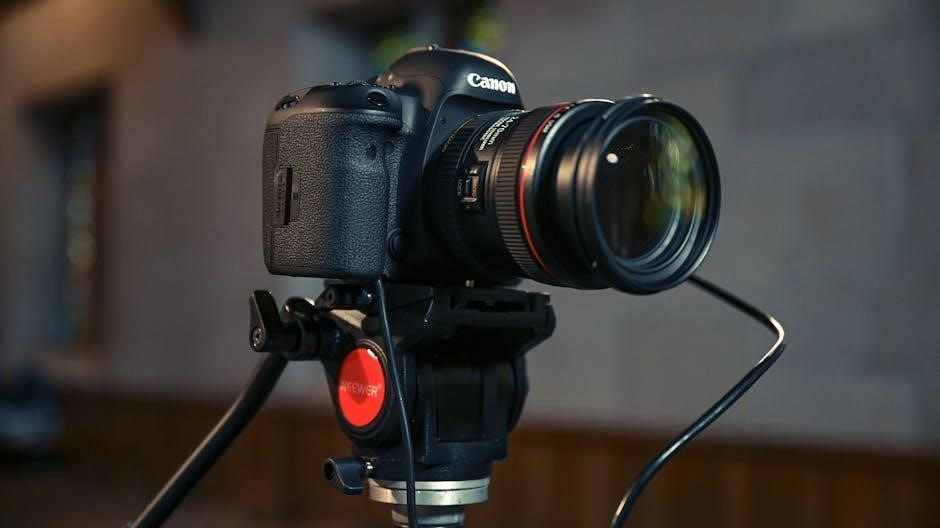The Canon EOS 7D is a high-performance DSLR camera designed for advanced photographers, offering an 18-megapixel APS-C CMOS sensor and dual DIGIC 4 processors for exceptional image quality․
1․1 Overview of the Canon 7D
The Canon EOS 7D is a high-performance DSLR camera designed for advanced photographers․ It features an 18-megapixel APS-C CMOS sensor, dual DIGIC 4 image processors, and captures stunning images with a maximum resolution of 5184 x 3456 pixels․ The camera supports 1080p HD video recording, manual audio level control, and offers a wide ISO range for versatility in various lighting conditions․ Its robust build and intuitive controls make it ideal for professionals and enthusiasts seeking high-quality results․
1․2 Importance of the Owner’s Manual
The Canon 7D owner’s manual is a comprehensive guide that helps users understand and utilize the camera’s advanced features effectively․ It provides detailed instructions for setup, shooting modes, customization, and troubleshooting․ This resource is essential for unlocking the camera’s full potential, ensuring optimal performance, and addressing common issues․ The manual also offers tips for maintenance and updates, making it an indispensable tool for both novice and experienced photographers․

Key Features of the Canon 7D
The Canon EOS 7D features an 18-megapixel APS-C CMOS sensor, dual DIGIC 4 processors for rapid processing, and 1080p HD video recording, making it ideal for stills and multimedia use․
2․1 18-Megapixel APS-C CMOS Sensor
The Canon EOS 7D is equipped with an 18-megapixel APS-C CMOS sensor, delivering high-resolution images with impressive detail․ This sensor ensures excellent low-light performance and dynamic range, capturing vibrant colors and fine textures․ Its compact size allows for a wide range of compatible lenses while maintaining portability, making it ideal for both professional photographers and enthusiasts seeking superior image quality in various shooting conditions․
2․2 Dual DIGIC 4 Image Processors
The Dual DIGIC 4 Image Processors in the Canon EOS 7D enhance image processing speed and quality․ These processors enable faster autofocus, improved noise reduction, and accurate color reproduction․ They also support advanced features like in-camera RAW processing and enhanced burst mode performance, ensuring smooth operation during high-speed shooting sessions․
2․3 1080p HD Video Recording
The Canon EOS 7D supports 1080p Full HD video recording at frame rates of 24, 25, or 30 fps․ This feature allows photographers to capture high-quality, cinematic-style footage with manual control over exposure and audio levels․ The camera also offers manual focus during recording and a live view mode for precise framing․ Combined with compatible EF-S lenses and external microphones, the 7D delivers professional-grade video capabilities for creative storytelling;

Camera Setup and Initial Configuration
Start by unboxing and inspecting the camera․ Charge the battery fully before first use․ Power on the device and follow on-screen prompts to set language, date, and time settings․
3;1 Unboxing and Physical Inspection
When unboxing, ensure all accessories are included, such as the camera body, battery, charger, and manual․ Inspect the device for any visible damage or defects․ Check the sensor and lens for dust or smudges․ Verify the integrity of the camera’s exterior, including buttons, ports, and the LCD screen․ Familiarize yourself with the layout to ensure proper functionality and readiness for initial setup․
3․2 Charging the Battery and First Power-On
Insert the LP-E6 battery into the charger and plug it into a power source․ Allow the battery to charge fully, indicated by a green light․ Once charged, insert the battery into the camera and power it on using the power switch․ Set your preferred language, date, and time during the initial setup․ Review all settings to ensure proper configuration for your first use․
3․4 Setting the Time and Date
To set the time and date on your Canon 7D, navigate to the camera’s menu and select the Date/Time option․ Use the arrow keys to adjust the settings․ Ensure the time zone is correct for your location․ Press the SET button to confirm․ For European date formats, use the CAPS LOCK key to toggle between day/month/year or month/day/year․ Accurate time and date settings are crucial for proper file naming and organization of your images․ Synchronize with an external GPS for location-based timestamping if desired․
Shooting Modes Explained
The Canon 7D offers a variety of shooting modes accessed via the mode dial, including Manual (M), Aperture Priority (Av), Shutter Priority (Tv), and Auto modes for diverse photography needs․
4․1 Understanding the Mode Dial
The Canon 7D features a mode dial that simplifies switching between shooting modes․ It includes Manual (M), Aperture Priority (Av), Shutter Priority (Tv), and Auto modes (Green Square and CA)․ Each mode offers unique control over camera settings, catering to different photography styles and skill levels․ The dial provides quick access to these options, allowing photographers to adapt to various shooting scenarios efficiently without navigating complex menus․
4․2 Manual Mode (M)
In Manual Mode (M), the Canon 7D offers complete control over exposure settings․ Photographers can adjust aperture, shutter speed, ISO, and white balance independently․ This mode is ideal for experienced users who prefer precise control over their shots․ The dual DIGIC 4 processors ensure rapid image processing, even with manual adjustments․ Use Manual Mode to achieve creative results in challenging lighting conditions or for specific artistic effects, leveraging the camera’s full potential for customization and flexibility․
4․3 Aperture Priority (Av)
In Aperture Priority (Av) mode, you set the aperture, and the Canon 7D automatically adjusts the shutter speed for proper exposure․ This mode is perfect for controlling depth of field, allowing you to blur backgrounds or keep landscapes sharp․ The dual DIGIC 4 processors ensure quick adjustments and precise results, making it ideal for creative photography where depth of field is critical, such as portraits or macro shots;
4․4 Shutter Priority (Tv)
In Shutter Priority (Tv) mode, you select the shutter speed, and the Canon 7D adjusts the aperture to maintain proper exposure․ This mode is ideal for capturing motion, allowing you to freeze fast-moving subjects or create artistic motion blur․ With the 18-megapixel sensor and dual DIGIC 4 processors, the camera ensures sharp, high-quality results, even in challenging lighting conditions, making it perfect for sports, wildlife, or creative photography where motion control is essential․
4․5 Auto Modes (Green Square and CA)
The Canon 7D features two fully automatic modes: Green Square (Full Auto) and CA (Creative Auto)․ In Full Auto, the camera controls all settings, making it ideal for beginners or quick shots․ Creative Auto allows basic adjustments like background blur and brightness while maintaining simplicity․ These modes are perfect for users who want to focus on composition without worrying about advanced settings, ensuring high-quality results with minimal effort․

Customization and Personalization
The Canon 7D allows extensive customization, enabling users to tailor settings to their preferences․ Custom functions and button assignments streamline workflows, enhancing creativity and efficiency during shooting sessions․
5․1 Custom Functions Overview
The Canon 7D offers a wide range of custom functions, allowing photographers to tailor camera settings to their preferences․ These functions cover various aspects, including autofocus, metering modes, and exposure controls․ Users can adjust settings like autofocus tracking sensitivity, AI Servo AF, and custom white balance․ These options enable photographers to fine-tune their camera for specific shooting scenarios, enhancing creativity and workflow efficiency․ The custom functions are accessed via the camera’s menu system, providing detailed control over its operations․
5․2 Assigning Buttons for Quick Access
The Canon 7D allows photographers to assign custom functions to specific buttons, enhancing workflow efficiency․ Users can reassign buttons like the AF-ON, AE Lock, and DOF Preview buttons to access frequently used settings quickly․ This customization enables faster access to features such as changing autofocus modes, adjusting metering options, or toggling between RAW and JPEG formats․ Personalizing button functions streamlines operations, making the camera more intuitive for individual shooting styles and preferences․
5․3 Saving Custom Settings
The Canon 7D allows users to save custom settings, ensuring quick access to personalized configurations․ By accessing the camera’s menu, photographers can store preferred shooting modes, autofocus settings, and button assignments․ These customizations are saved in the camera’s memory, maintaining consistency across photo sessions․ This feature is particularly useful for photographers who frequently switch between different shooting scenarios, as it eliminates the need to reset preferences repeatedly, enhancing workflow efficiency and adaptability during dynamic photography sessions․

Accessories and Compatibility
The Canon 7D supports a wide range of accessories, including lenses, tripods, remote shutters, and external flashes, enhancing its versatility for diverse photography needs and styles․
6․1 Compatible Lenses for the Canon 7D
The Canon 7D is compatible with a wide range of EF and EF-S mount lenses, offering versatility for various photography needs․ Popular options include the EF 24-70mm f/2․8L II USM for portraits, the EF 70-200mm f/2․8L IS III USM for telephoto shots, and the EF-S 10-22mm f/3․5-4․5 USM for wide-angle photography․ These lenses enhance the camera’s performance, catering to both professionals and enthusiasts, ensuring high-quality results across different genres․
6․2 Tripods and Remote Shutter Release
Using a tripod with the Canon 7D ensures stability, especially in low-light or long-exposure situations․ Look for tripods compatible with the 1/4-inch mount․ Remote shutter releases, like the Canon RC-6, eliminate camera shake caused by pressing the shutter button․ These accessories are essential for sharp images and professional results, reducing blur and noise in challenging lighting conditions․
6․3 External Flash and Lighting
Enhance your photography with external flash units like the Canon Speedlite series, designed for compatibility with the Canon 7D․ These units provide advanced lighting control, reducing harsh shadows and enhancing creativity․ Use the camera’s hot shoe or wireless options for flexible setups․ Proper lighting techniques ensure balanced exposures and professional results, making external flashes indispensable for capturing stunning images in various lighting conditions․

Maintenance and Care
Regularly clean the sensor and lens with a soft cloth to prevent dust buildup․ Proper care ensures optimal performance and longevity of your Canon 7D․
7․1 Cleaning the Sensor and Lens
Regular cleaning of the Canon 7D’s sensor and lens is essential for maintaining image quality․ Use a soft, dry cloth or a blower to gently remove dust․ Avoid touching the sensor surface to prevent damage․ For stubborn spots, use a cleaning solution recommended by Canon․ Always refer to the manual for detailed cleaning instructions to ensure proper care and avoid potential harm to your camera․
7․2 Updating Firmware
Updating the Canon 7D’s firmware ensures optimal performance and unlocks new features․ Download the latest firmware from Canon’s official website, then follow the on-screen instructions to install it․ Ensure the camera is fully charged and avoid interruptions during the update․ Firmware updates may enhance functionality, improve compatibility, or fix bugs, keeping your camera up-to-date with the latest advancements․ Always refer to the manual for detailed guidance on this process․
7․3 Regular Software Updates
Regular software updates are crucial for maintaining the Canon 7D’s functionality and performance․ These updates often include enhancements for image processing, compatibility with new lenses, and improved operational efficiency․ Users should periodically check Canon’s official website for the latest software releases․ Updates can be installed via the camera’s menu system or using Canon’s EOS Utility․ Always follow the provided instructions carefully to ensure a smooth and successful update process for your camera․

Advanced Features and Techniques
The Canon 7D offers advanced features like ISO control, white balance adjustments, and flash techniques, enabling photographers to refine their shots for optimal results․
8․1 Understanding ISO and Noise Reduction
The Canon 7D allows photographers to adjust ISO settings, balancing light sensitivity and image quality․ Lower ISOs (100-400) minimize noise, while higher settings (6400-12800) introduce grain but enable shooting in low light․ The camera features noise reduction options to maintain clarity, especially in high-ISO shots․ Firmware updates have enhanced noise handling, providing cleaner images across the ISO spectrum․
8․2 White Balance and Color Accuracy
The Canon 7D offers precise white balance control, ensuring accurate color representation․ Preset options like daylight, shade, and tungsten adapt to lighting conditions, while custom settings enable manual adjustments for specific scenes․ The camera’s advanced sensors and DIGIC 4 processors enhance color accuracy, delivering vibrant and natural hues․ Firmware updates further optimize these features, providing professional-grade results․
8․3 Using the Built-In Flash
The Canon 7D features a built-in flash for convenient lighting in low-light conditions․ It automatically activates in auto modes and can be manually controlled for custom illumination․ The flash supports E-TTL II technology for accurate exposure and includes bounce capabilities for creative lighting effects․ Firmware updates enhance flash performance, ensuring compatibility with external units and improving synchronization․ This feature is invaluable for both amateur and professional photographers seeking versatile lighting solutions․

Troubleshooting Common Issues
This section helps users identify and resolve common problems with the Canon 7D, such as error messages, autofocus issues, and battery drain, ensuring smooth camera operation․
9․1 Resolving Error Messages
When encountering error messages on your Canon 7D, such as “ERR 01” or “ERR 02,” refer to the manual for specific solutions․ These issues often relate to lens communication or memory card problems․ Turn the camera off and on, clean the lens contacts, or reformat the memory card․ If errors persist, update the firmware or contact Canon support for further assistance to ensure optimal camera performance and functionality․
9․2 Solving Autofocus Problems
If your Canon 7D experiences autofocus issues, reset the AF system by turning the camera off and on․ Ensure the lens is properly attached and clean the contacts․ Check AF settings in the menu, ensuring the correct mode (ONE SHOT or AI SERVO) is selected․ Update the camera firmware if available, as newer versions often improve autofocus performance․ Consult the manual for additional troubleshooting steps to restore sharp focus and optimal functionality․
9;3 Addressing Battery Drain Issues
To address battery drain on your Canon 7D, ensure power-hungry features like image stabilization and continuous autofocus are disabled when not needed․ Use the camera’s power-saving mode or turn off unnecessary settings like GPS․ Regularly check battery health and replace old batteries․ Update firmware to improve efficiency․ Avoid extreme temperatures and store batteries properly․ These steps will help extend battery life and improve overall performance․

Firmware Updates and Enhancements
Firmware updates for the Canon EOS 7D enhance functionality, adding features like in-camera RAW processing and GPS support, while improving camera performance and buffer capacity significantly․
10․1 Benefits of Updating Firmware
Updating the Canon EOS 7D firmware enhances functionality and performance․ It adds features like manual audio control and in-camera RAW processing, improving versatility for photographers․ Firmware updates also boost compatibility with Canon lenses and flashes, ensuring optimal performance․ Additionally, updates may improve buffer capacity, allowing more consecutive RAW images, and address minor bugs for a smoother user experience․ Regular updates are essential to unlock your camera’s full potential and maintain peak performance․
10․2 Step-by-Step Firmware Update Guide
To update your Canon EOS 7D firmware, start by downloading the latest version from the official Canon website․ Connect your camera to a computer via USB, ensuring the battery is fully charged․ Transfer the firmware file to the camera’s memory card or directly to the device․ Navigate to the camera’s menu, select the firmware update option, and follow the on-screen instructions․ After completion, restart the camera to apply the updates․

Downloading and Navigating the Manual
Access the official Canon 7D manual on Canon’s website․ Download the PDF file and use bookmarks or the search function to navigate through sections easily and efficiently․
11․1 Finding the Official Canon 7D Manual
To locate the official Canon 7D manual, visit Canon’s website and navigate to the support section․ Search for the EOS 7D model, and download the PDF manual directly․ Ensure you select the correct version for your camera, as multiple editions may be available․ The manual is comprehensive, covering all features, settings, and troubleshooting guides․ Always verify the source to ensure authenticity and avoid unauthorized downloads․
11․2 Navigating the PDF Manual
The official Canon 7D PDF manual is structured for easy navigation․ Use the table of contents or bookmarks to access specific sections quickly․ The manual includes detailed explanations of camera features, shooting modes, and customization options․ Utilize the search function to find topics like autofocus settings or firmware updates․ Important sections are highlighted for quick reference, ensuring users can efficiently explore and understand the camera’s capabilities․ Regular updates may be available for the manual as well․
The Canon 7D is a powerful tool for advanced photographers, offering high-quality imaging and customization options․ The manual is essential for maximizing its potential․ Happy shooting!
12․1 Recap of Key Features and Setup
The Canon 7D boasts an 18-megapixel APS-C CMOS sensor, dual DIGIC 4 processors, and 1080p HD video recording․ Initial setup includes unboxing, battery charging, and time/date configuration․ Customization options like button assignments and custom functions enhance usability․ Regular firmware updates ensure optimal performance․ Proper sensor cleaning and lens maintenance are crucial for longevity․ The owner’s manual is indispensable for mastering these features and troubleshooting common issues effectively․
12․2 Final Tips for Getting the Most Out of Your 7D
Maximize your Canon 7D experience by staying updated with the latest firmware for enhanced features and performance․ Experiment with manual modes to refine your photography skills․ Regularly clean the sensor and lenses to maintain image clarity․ Utilize custom functions and button assignments for personalized control․ Invest in high-quality lenses and accessories to unlock the camera’s full potential․ Troubleshoot common issues promptly to ensure uninterrupted usage and optimal results․
